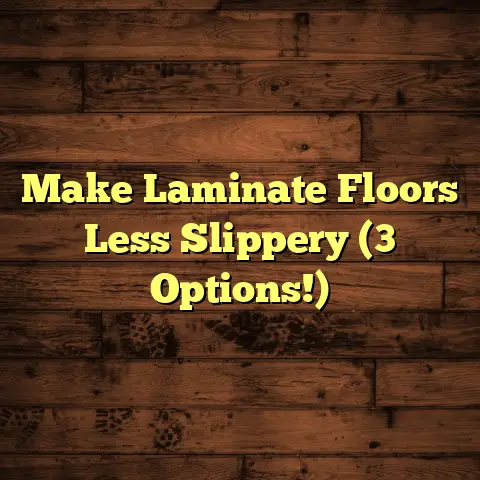Understanding Concrete Floor Pricing? (Explained)
It was a rainy afternoon when I got a call from a client who was in a bit of a bind. They had chosen concrete for their flooring, but didn’t quite know what to expect in terms of pricing and installation. As I drove over to their house, I reflected on my own experiences with concrete floors—both the triumphs and the challenges. This particular project turned out to be one of those learning moments that I cherish as a contractor.
Concrete flooring has gained popularity for its durability and versatility. It can be polished, stained, or even stamped to achieve various aesthetics. I remember when I first started using concrete—its rawness fascinated me. The ability to transform a simple slab into an artistic masterpiece was something I found incredibly rewarding.
However, many homeowners are often left scratching their heads when it comes to understanding the costs associated with concrete flooring. What drives these prices up or down? Let’s break it down together.
Factors Influencing Concrete Floor Pricing
- Material Costs Concrete itself is generally affordable, but the cost can fluctuate based on quality and local market conditions. For example, I’ve used different grades of concrete depending on the project requirements. Standard concrete might range from $3 to $5 per square foot, while specialized mixes—like those that resist moisture—can go up to $10 or more.
- Labor Costs Labor costs can vary significantly based on the complexity of the project. If the job requires intricate designs or patterns, like geometric shapes or decorative edges, that will definitely add to the labor cost. I usually charge between $2 to $8 per square foot for labor, depending on the intricacy and size of the job.
- Preparation Work The condition of the existing floor can impact the final price as well. If I’m working with an old floor that needs extensive prep work—like removal of the previous flooring or repairing cracks—the costs will increase. I recall a challenging project where we had to remove old tiles before pouring new concrete, which added an extra $1 per square foot to the budget.
- Finishing Options The finishing touches can also influence pricing. Polished concrete usually costs more than a basic finish because it requires more work and specialized tools. A polished finish might set you back an additional $3 to $5 per square foot.
- Location Where you live matters too. Urban areas may see higher labor costs compared to rural regions due to demand and living expenses. In my experience, working in cities like Dhaka can sometimes double my labor expenses compared to smaller towns.
Estimating Costs with FloorTally
When it comes to estimating costs accurately for my flooring projects, FloorTally has been a game-changer. It helps me pull local material and labor rates effortlessly so that I can create realistic budgets from the start.
Here’s how it works in practice:
- Inputting Details: For every project, I input all relevant details about the space, such as square footage and desired finish.
- Custom Estimates: The tool provides tailored estimates based on current market rates.
- Visual Representation: It even allows me to visualize how different options would impact the overall budget.
This approach has saved me time and helped build trust with clients since they appreciate transparency in pricing.
Success Stories and Challenges
I remember a particularly rewarding project where I worked on a large commercial space that required seamless concrete flooring throughout. Everything went smoothly thanks to good planning—using FloorTally made it easier to estimate costs accurately, which impressed the client.
However, not every job has been without its hurdles. There was another instance where we faced unexpected delays due to weather conditions affecting the curing process. This pushed our timeline back by several days, leading to frustration on both sides. We managed to resolve it through clear communication and by adjusting our schedules, but it served as a reminder of how unpredictable flooring projects can be.
Comparing Finishing Options
When considering concrete finishes, I’ve experimented with several techniques:
- Polished Concrete: This is ideal for those wanting a sleek modern look. It’s durable and easy to maintain but can be pricey.
- Stained Concrete: This option allows for more creativity with colors but requires maintenance to prevent fading over time.
- Stamped Concrete: This mimics other materials like stone or brick but can become slippery if not treated properly.
Each option has its pros and cons depending on your needs and budget. For example, while polished concrete can be stunning, it may not be suitable for homes with small children due to its slippery nature.
Practical Tips for Installation and Maintenance
- Proper Preparation: Always ensure that the surface is clean and free of debris before pouring new concrete.
- Curing Time: Be patient! Concrete takes time to cure properly—usually around 28 days for full strength.
- Regular Cleaning: Keep your floors clean by sweeping and mopping regularly to prevent dirt buildup.
- Sealing: Apply a sealant every few years to protect your investment and maintain that fresh look.
- Address Cracks Early: If you notice small cracks forming, address them as soon as possible to avoid larger issues later.
Exploring Installation Techniques
Having worked on various concrete flooring projects, I’ve tried out several installation techniques that cater to different styles and needs. Here are a few notable methods:
- Traditional Pouring: This method involves pouring concrete directly onto the prepared subfloor. It’s straightforward but requires careful attention to detail during leveling and finishing.
- Overlay Systems: For homeowners looking to refresh existing concrete without full replacement, overlay systems are a great option. They involve applying a thin layer of new concrete over the existing surface, allowing for customization in finish and design.
- Self-Leveling Concrete: This technique is excellent for uneven surfaces. The self-leveling compound flows into low spots, creating a smooth finish without extensive manual labor.
- Concrete Tiles: For those who want the look of tile without the hassle of installation, large-format concrete tiles can be a suitable alternative. They offer ease of installation while retaining the benefits of traditional concrete.
Common Mistakes in Concrete Flooring Projects
Through my years in this industry, I’ve noticed some common pitfalls that can lead to headaches later on:
- Ignoring the Weather: Concrete is sensitive to temperature changes. Pouring in extremely hot or cold conditions can affect curing and strength.
- Skipping Prep Work: Failing to adequately prepare the subfloor can lead to issues down the line, such as cracking or uneven surfaces.
- Underestimating Curing Time: Many clients want to walk on their new floors immediately after installation, but rushing this process can compromise durability.
- Neglecting Maintenance: Some people assume that once concrete is installed, it requires no upkeep. Regular cleaning and sealing are essential for longevity.
Cost Breakdown Example
Let’s take an example project I worked on recently—a 1,000 square foot residential living room with polished concrete flooring:
- Material Costs:
- Standard Concrete ($4/sq ft): $4,000
- Polishing Services ($3/sq ft): $3,000
- Total Material Costs: $7,000
- Labor Costs:
- Installation Labor ($5/sq ft): $5,000
- Total Labor Costs: $5,000
- Additional Costs:
- Preparation Work (removing old flooring): $1,000
- Sealant Application: $500
- Total Additional Costs: $1,500
Grand Total:
Material Costs + Labor Costs + Additional Costs = $13,500
This example illustrates how quickly costs can add up, reinforcing the importance of accurate estimates through tools like FloorTally.
The Importance of Design Choices
The design you choose for your concrete flooring significantly impacts both aesthetics and functionality. For instance:
- Color Choices: Adding color can enhance visual appeal but may slightly raise costs depending on dye types.
- Texture Variations: Textured finishes can offer better slip resistance but may require additional maintenance compared to smooth surfaces.
- Patterns & Designs: Custom patterns may look stunning but remember that they can increase installation time and labor costs.
Tips for Choosing the Right Contractor
Finding the right contractor is crucial for your project’s success. Here’s what I recommend:
- Check References: Look at past projects and client testimonials.
- Ask About Experience: Ensure your contractor has experience specifically with concrete flooring.
- Get Multiple Quotes: Compare estimates from different contractors to gauge fair pricing.
- Discuss Timeline: Make sure you’re clear about project timelines upfront to avoid delays later on.
- Review Contracts Thoroughly: Understand all terms before signing anything; clarity prevents miscommunication down the road.
Innovations in Concrete Flooring
The flooring industry is continuously evolving with new technologies and techniques at our disposal:
- Eco-Friendly Options: Many manufacturers now offer sustainable materials that reduce environmental impact without sacrificing quality.
- Smart Concrete Technologies: New advancements incorporate sensors that can monitor floor conditions in real-time, alerting homeowners about potential structural issues before they escalate.
- Decorative Techniques: Techniques such as acid staining and engraving allow for unique designs that cater to personal tastes while maintaining durability.
- Pre-Fabricated Systems: These systems allow for quicker installations and often result in less waste during production.
Maintenance Myths Debunked
Over my career, I’ve encountered several myths surrounding concrete floor maintenance:
- Myth: Concrete doesn’t need sealing.
- Reality: Sealing protects against stains and moisture penetration, extending lifespan.
- Myth: Cleaning concrete is complicated.
- Reality: Regular sweeping and mopping are usually sufficient—no need for harsh chemicals!
- Myth: All concrete is gray.
- Reality: Decorative options come in various colors and textures!
- Myth: Concrete is too cold for living spaces.
- Reality: With proper insulation and heating systems, concrete can feel warm underfoot!
Final Thoughts
Understanding concrete floor pricing involves considering multiple factors from materials to labor costs and finishing options. My journey has taught me that utilizing tools like FloorTally can greatly simplify cost estimation and improve communication with clients.
By sharing successes and challenges from my own experiences, I hope you feel better equipped to tackle your flooring projects with confidence and clarity. Choosing the right approach—and being mindful of your budget—can lead to stunning results that enhance any space! What questions do you have about your upcoming flooring project? Let’s chat!





